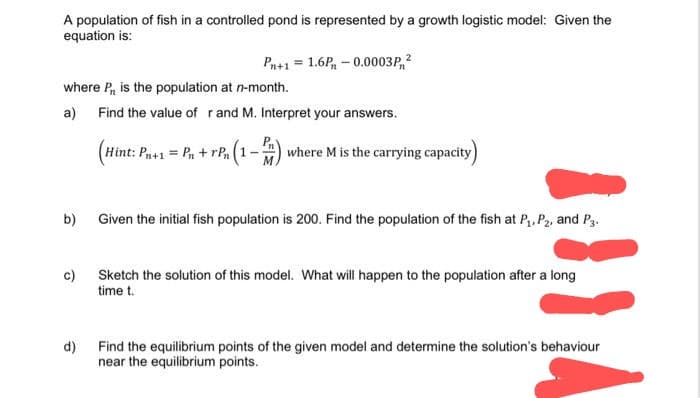A population of fish in a controlled pond is represented by a growth logistic model: Given the equation is: Pn+1 = 1.6P - 0.0003P,² where P, is the population at n-month. a) Find the value of rand M. Interpret your answers. (Hint: Hint: Pn+1 = P + rP (1-1 = P₁ + rP₂ ( 1 - where M is the carrying capacity) b) Given the initial fish population is 200. Find the population of the fish at P₁, P2, and P3. c) Sketch the solution of this model. What will happen to the population after a long time t. d) Find the equilibrium points of the given model and determine the solution's behaviour near the equilibrium points.
A population of fish in a controlled pond is represented by a growth logistic model: Given the equation is: Pn+1 = 1.6P - 0.0003P,² where P, is the population at n-month. a) Find the value of rand M. Interpret your answers. (Hint: Hint: Pn+1 = P + rP (1-1 = P₁ + rP₂ ( 1 - where M is the carrying capacity) b) Given the initial fish population is 200. Find the population of the fish at P₁, P2, and P3. c) Sketch the solution of this model. What will happen to the population after a long time t. d) Find the equilibrium points of the given model and determine the solution's behaviour near the equilibrium points.
Chapter6: Exponential And Logarithmic Functions
Section6.8: Fitting Exponential Models To Data
Problem 56SE: Recall that the general form of a logistic equation for a population is given by P(t)=c1+aebt , such...
Related questions
Question

Transcribed Image Text:A population of fish in a controlled pond is represented by a growth logistic model: Given the
equation is:
Pn+1 = 1.6P - 0.0003P, ²
where P, is the population at n-month.
a) Find the value of r and M. Interpret your answers.
(Hint: Pn+1 = Pn + rPn (1-
(1-2),
where M is the carrying capacity)
b)
Given the initial fish population is 200. Find the population of the fish at P₁, P₂, and P3.
c)
Sketch the solution of this model. What will happen to the population after a long
time t.
d)
Find the equilibrium points of the given model and determine the solution's behaviour
near the equilibrium points.
Expert Solution
This question has been solved!
Explore an expertly crafted, step-by-step solution for a thorough understanding of key concepts.
Step by step
Solved in 5 steps with 1 images

Recommended textbooks for you


Algebra & Trigonometry with Analytic Geometry
Algebra
ISBN:
9781133382119
Author:
Swokowski
Publisher:
Cengage


Algebra & Trigonometry with Analytic Geometry
Algebra
ISBN:
9781133382119
Author:
Swokowski
Publisher:
Cengage